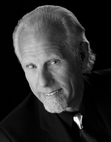Paul Bishop's Blog, page 7
September 28, 2019
WESTERN NOVELS—A MULE FOR THE MARQUESA
 WESTERN NOVELS
WESTERN NOVELSA MULE FOR THE MARQUESA
Frank O’Rourke’s novel A Mule for the Marquesaunderwent a name change to The Professionals when it moved from page to screen. Movie tie-in versions and subsequent reprints all retained the punchier title. The Professionals begins as a straightforward Western actioneer, but packs a kick by the time the last page is turned. A group of Mexican revolutionaries have kidnapped Angelina Grant, the fiery Mexican wife of American cattle baron Augustus Grant. The arrogant, very rich, Grant recruits a band of five larger-than-life soldiers of fortune—led by ex-cavalryman turned arms dealer Henry Fardan—to cross the desert and rescue his wife. Each man is a hardened expert in logistics, combat, explosives or improvisation. The caper—five men against a hundred—is ingenious, exciting and vividly told.
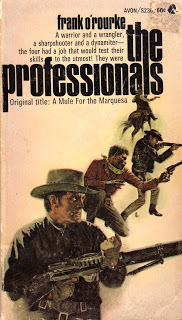 While he wrote dozens of other Western, sports, and detective novels, Frank O’Rourke specialized in writing caper novels with western locals. The Professionals is a prime example of this talent. A number of his other books, including The Bravados and The Great Bank Robbery, also made their way onto the silver screen. Of his traditional Westerns, Warbonnet Lawcontains his strongest character, range detective John McMahon. His most memorable character, however, is Andres ShotgunArau who battles his way through the 1910 Mexican revolution in The Shotgun Man. His companions are a beautiful woman, a .97 shotgun and a hidden fortune with killers on his trail.
While he wrote dozens of other Western, sports, and detective novels, Frank O’Rourke specialized in writing caper novels with western locals. The Professionals is a prime example of this talent. A number of his other books, including The Bravados and The Great Bank Robbery, also made their way onto the silver screen. Of his traditional Westerns, Warbonnet Lawcontains his strongest character, range detective John McMahon. His most memorable character, however, is Andres ShotgunArau who battles his way through the 1910 Mexican revolution in The Shotgun Man. His companions are a beautiful woman, a .97 shotgun and a hidden fortune with killers on his trail. 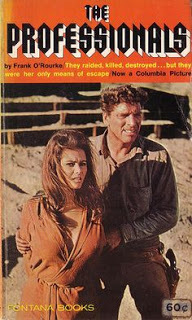 The Professionals is second only to The Magnificent Seven as my favorite Western film. Watching Lee Marvin and Burt Lancaster relish chewing the scenery together while trying to out macho each other in The Professionals is sheer late night viewing entertainment. The movie led me to the book, and to the discovery of the sheer Western storytelling power of Frank O’Rourke.
The Professionals is second only to The Magnificent Seven as my favorite Western film. Watching Lee Marvin and Burt Lancaster relish chewing the scenery together while trying to out macho each other in The Professionals is sheer late night viewing entertainment. The movie led me to the book, and to the discovery of the sheer Western storytelling power of Frank O’Rourke.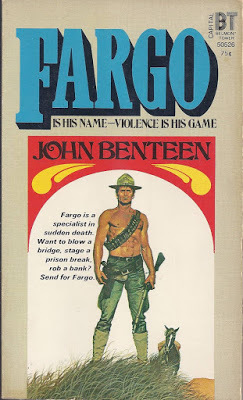 Writing under his John Benteen pseudonym, revered Western writer Ben Haas based his iconic Western adventure character, Fargo—with only a few changes to avoid problems—on both the Henry Fardan of O’Rourke’s novel and the portrayal of Fardan by Lee Marvin in The Professionals, the movie based on the book. After seeing his portrayal of Fardan in The Professionals, it is effortless to imagine ex-Marine Lee Marvin as the rock-hard fighting man, ex-Rough Rider, wildcatter and mercenary of the Fargo adventures.
Writing under his John Benteen pseudonym, revered Western writer Ben Haas based his iconic Western adventure character, Fargo—with only a few changes to avoid problems—on both the Henry Fardan of O’Rourke’s novel and the portrayal of Fardan by Lee Marvin in The Professionals, the movie based on the book. After seeing his portrayal of Fardan in The Professionals, it is effortless to imagine ex-Marine Lee Marvin as the rock-hard fighting man, ex-Rough Rider, wildcatter and mercenary of the Fargo adventures.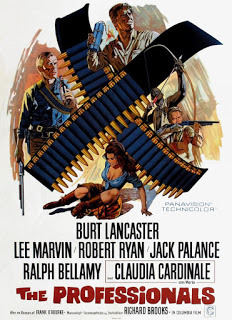 With a screenplay adaptation and direction by Richard Brooks, The Professionals (1966) is stunningly filmed across the salt flats of Death Valley and Desolation Canyon. Matching the harshness of the landscape, Lee Marvin, Burt Lancaster, Woody Strode Robert Ryan and Jack Palance are at their hard-ass best. Claudia Cardinale gives a smoldering performance as the dark-haired kidnapped wife, while the perfectly cast Marie Gomez knocks your eyes out as Chiquita—truly a woman to lead a revolution.
With a screenplay adaptation and direction by Richard Brooks, The Professionals (1966) is stunningly filmed across the salt flats of Death Valley and Desolation Canyon. Matching the harshness of the landscape, Lee Marvin, Burt Lancaster, Woody Strode Robert Ryan and Jack Palance are at their hard-ass best. Claudia Cardinale gives a smoldering performance as the dark-haired kidnapped wife, while the perfectly cast Marie Gomez knocks your eyes out as Chiquita—truly a woman to lead a revolution. 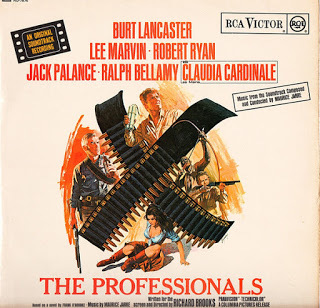 Nominated for three Academy Awards, The Professionals was the first Western to feature nudity, although it is a long-range view and tame by later standards. The Professionals is filled with shooting, betrayal and explosions, with tough men and tougher women. Like the novel it is based on, the movie is a no-frills, straightforward, six-gun and dynamite actioneer—a totally satisfying viewing experience and an antidote to modern CGI overload.
Nominated for three Academy Awards, The Professionals was the first Western to feature nudity, although it is a long-range view and tame by later standards. The Professionals is filled with shooting, betrayal and explosions, with tough men and tougher women. Like the novel it is based on, the movie is a no-frills, straightforward, six-gun and dynamite actioneer—a totally satisfying viewing experience and an antidote to modern CGI overload.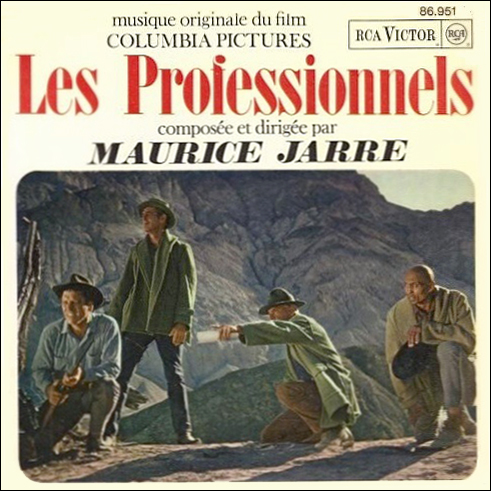
Published on September 28, 2019 21:25
September 26, 2019
FORGOTTEN WESTERNS—THE FASTEST GUITAR ALIVE
 FORGOTTEN WESTERNS THE FASTEST GUITAR ALIVE I enjoy genre oddities. Among them are hidden gems at one end of the spectrum and spectacular, ill-conceived train wrecks at the other. The Fastest Guitar Alive(1967) is closer to the train wreck end of the spectrum, but does have a few redeeming qualities.
FORGOTTEN WESTERNS THE FASTEST GUITAR ALIVE I enjoy genre oddities. Among them are hidden gems at one end of the spectrum and spectacular, ill-conceived train wrecks at the other. The Fastest Guitar Alive(1967) is closer to the train wreck end of the spectrum, but does have a few redeeming qualities. 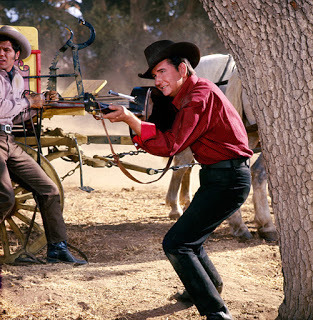 Producer Sam Katzman, who did Kissin' Cousins (1964) and Harum Scarum (1965) with Elvis, must have thought there was an audience just waiting for another singing cowboy Western to hit the big screen. But when Elvis (or more likely Colonel Parker) took a pass on the lead role, and Ricky Nelson also walked away, it should have been a big hint for Katzman to fold up his script and send it riding off into the sunset without another glance.
Producer Sam Katzman, who did Kissin' Cousins (1964) and Harum Scarum (1965) with Elvis, must have thought there was an audience just waiting for another singing cowboy Western to hit the big screen. But when Elvis (or more likely Colonel Parker) took a pass on the lead role, and Ricky Nelson also walked away, it should have been a big hint for Katzman to fold up his script and send it riding off into the sunset without another glance. 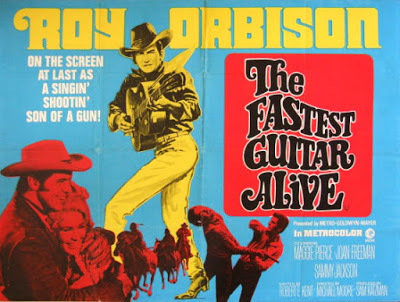 Singer Roy Orbison was a bit of an oddity himself. His music was a rockabilly/pop hybrid that didn’t sound like anyone else who was getting airplay on the radio From 1960 to 1966, he had twenty-two singles reach the Billboard Top 40. He wrote or co-wrote almost all that rose to the Top 10, including Only the Lonely (1960), Running Scared (1961), Crying (1961), In Dreams (1963), and Oh, Pretty Woman (1964). However, Orbison did not have the traditional pop star looks. If fact, it was said he had a face made for radio. Orbison was a hot commodity in the music business, but translating that into becoming a movie star, especially with no prior acting experience, was a tragic misstep.
Singer Roy Orbison was a bit of an oddity himself. His music was a rockabilly/pop hybrid that didn’t sound like anyone else who was getting airplay on the radio From 1960 to 1966, he had twenty-two singles reach the Billboard Top 40. He wrote or co-wrote almost all that rose to the Top 10, including Only the Lonely (1960), Running Scared (1961), Crying (1961), In Dreams (1963), and Oh, Pretty Woman (1964). However, Orbison did not have the traditional pop star looks. If fact, it was said he had a face made for radio. Orbison was a hot commodity in the music business, but translating that into becoming a movie star, especially with no prior acting experience, was a tragic misstep. 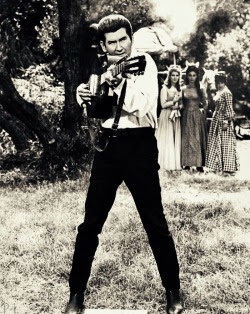 Orbison was partly to blame. He love the movies and when he could break away from touring, writing, and recording, he would often see three films a day. He had also allowed his agent to move him agent, moved him from Monument Records to Metro-Goldwyn-Mayer for a million dollar payday and his promise to follow in the footsteps of Elvis Presley and pursue the wider exposure brought by movie and TV roles.
Orbison was partly to blame. He love the movies and when he could break away from touring, writing, and recording, he would often see three films a day. He had also allowed his agent to move him agent, moved him from Monument Records to Metro-Goldwyn-Mayer for a million dollar payday and his promise to follow in the footsteps of Elvis Presley and pursue the wider exposure brought by movie and TV roles. Filming of The Fastest Guitar Alive began in September 1966. Although Orbison was pleased with the film, it proved to be a major critical and box office disaster. The idea of a musical Western set near the end of the Civil War—and the family tragedies and devastation wreaked by the conflict—simply didn’t resonate with potential audiences. While MGM had included five films in Orbison’s million dollar contract, the flop of The Fastest Guitar Alive was so spectacular no more were made.
If played as a straight Western, the plot of the movie is intriguing. In some ways it’s a twist on the Errol Flynn/Randolph Scott western Virginia City, with which it shares a number of similarities. Johnny Banner (Orbison) is a Confederate spy posing as roving musician. With the gimmick of a gun hidden in his guitar, he’s sort of a guitar-slinging, singing, gunslick. Banner’s sidekick, Steve Menlo (Sammy Jackson), poses as the proprietor of Dr. Ludwig Long's Magic Elixir traveling medicine show. This supposedly allows him to wander into the same places as Banner without drawing suspicion.
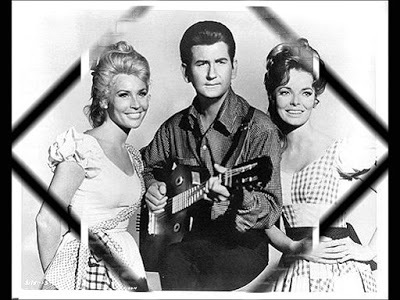 President Jefferson Davis has tasked the duo with robbing gold bullion from the United States Mint in San Francisco in order to help finance the Confederacy's war effort. They are to deliver the gold to a general in El Paso—where the Confederacy has emergency plans to flee and regroup. However, immediately after Banner and Menlo steal the gold, the war comes to a sputter halt. They now find themselves on the run trying to evade not only pursuers from both sides of the conflict and wild red face Injuns, but also the affections of the dancing, lovelorn , Chestnut sisters (Maggie Pierce and Joan Freeman). Misadventures ensue.
President Jefferson Davis has tasked the duo with robbing gold bullion from the United States Mint in San Francisco in order to help finance the Confederacy's war effort. They are to deliver the gold to a general in El Paso—where the Confederacy has emergency plans to flee and regroup. However, immediately after Banner and Menlo steal the gold, the war comes to a sputter halt. They now find themselves on the run trying to evade not only pursuers from both sides of the conflict and wild red face Injuns, but also the affections of the dancing, lovelorn , Chestnut sisters (Maggie Pierce and Joan Freeman). Misadventures ensue. 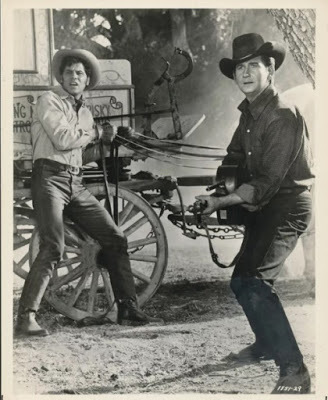 While most of the song’s Orbison co-wrote Bill Dees were solid efforts, the sound of an electric guitar and orchestra in the Wild West was an off-key anachronism. There was also the problem of portray the Injuns chasing Banner and Menlo as kooky comic relief. The script treatment of these characters was so crass even the presence of Iron Eyes Cody couldn’t salvage the spanner clang of political incorrectness.
While most of the song’s Orbison co-wrote Bill Dees were solid efforts, the sound of an electric guitar and orchestra in the Wild West was an off-key anachronism. There was also the problem of portray the Injuns chasing Banner and Menlo as kooky comic relief. The script treatment of these characters was so crass even the presence of Iron Eyes Cody couldn’t salvage the spanner clang of political incorrectness. If The Fastest Guitar Alive had been a crime, no-bail warrants would have been issued and the statute of limitations would still be active.
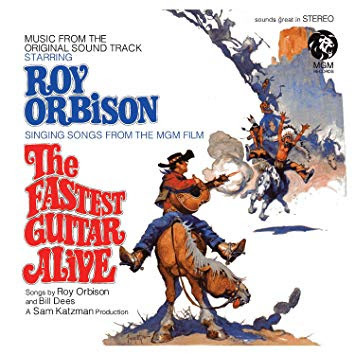 While the movie was unremarkable (to be kind), the original poster art by the great Frank Frazetta was awesome. Frazetta’s art also graced The Fastest Guitar Alive soundtrack, which was released as Orbison's eleventh studio album by MGM Records in 1967. It was the only Orbison LP to consist entirely of Roy Orbison/Bill Dees originals. Its single, There Won't be Many Coming Home, reached #18 in the UK and entered the Australian chart at its highest position of #32 before slipping down the chart. This foreshadowed a major downturn in Orbison’s career, which was also affected by a number of personal tragedies.
While the movie was unremarkable (to be kind), the original poster art by the great Frank Frazetta was awesome. Frazetta’s art also graced The Fastest Guitar Alive soundtrack, which was released as Orbison's eleventh studio album by MGM Records in 1967. It was the only Orbison LP to consist entirely of Roy Orbison/Bill Dees originals. Its single, There Won't be Many Coming Home, reached #18 in the UK and entered the Australian chart at its highest position of #32 before slipping down the chart. This foreshadowed a major downturn in Orbison’s career, which was also affected by a number of personal tragedies. 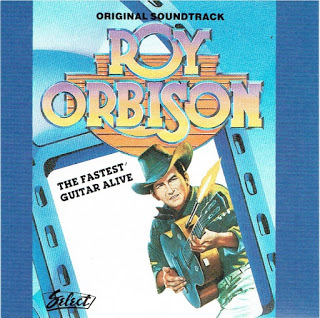 In the 1980s, Orbison experienced a resurgence in popularity following the success of several cover versions of his songs. In 1988, he co-founded the rock supergroup Traveling Wilburys with George Harrison, Bob Dylan, Tom Petty, and Jeff Lynne. Orbison died of a heart attack in December 1988 at the age of 52. One month later, his song You Got It (1989), co-written with Lynne and Petty, was released as a solo single and became his first hit to reach the U.S. Top 10 in nearly 25 years.
In the 1980s, Orbison experienced a resurgence in popularity following the success of several cover versions of his songs. In 1988, he co-founded the rock supergroup Traveling Wilburys with George Harrison, Bob Dylan, Tom Petty, and Jeff Lynne. Orbison died of a heart attack in December 1988 at the age of 52. One month later, his song You Got It (1989), co-written with Lynne and Petty, was released as a solo single and became his first hit to reach the U.S. Top 10 in nearly 25 years.
Published on September 26, 2019 17:52
September 25, 2019
FORGOTTEN TV WESTERNS—WAGON TRAIN
 FORGOTTEN TV WESTERNS
FORGOTTEN TV WESTERNSWAGON TRAINWhile not necessarily forgotten, if you mentioned the TV show Wagon Train to a Millennial or Gen-Xer, you would most certainly receive a blank look in reply. Yet for eight years first on NBC (1957-1962) and later on ABC (1963-1965), the Wagon Train led its Conestoga wagons on the post-Civil War trail from Missouri to California.
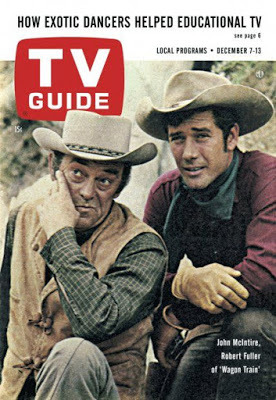 Episode by episode the journey became one of the longest cross country journeys of all time. The ups and downs of life on the trail echoed Wagon Train's travels up and down the Nielsen Ratings, including peaking at the top of the proverbial Rockies in the number one spot.
Episode by episode the journey became one of the longest cross country journeys of all time. The ups and downs of life on the trail echoed Wagon Train's travels up and down the Nielsen Ratings, including peaking at the top of the proverbial Rockies in the number one spot. Wagon Train was directly inspired by the 1950s film Wagon Master directed by John Ford, who would notably direct an episode of the TV series in 1960. Wagon Master starred Ben Johnson and Harry Carrey, Jr., as well as Ward Bond, who would later take on Wagon Train's lead role. The show also borrowed liberally from John Wayne's 1930 film The Big Trail, in which Ward Bond also appeared, making his feature film debut. Ward Bond's long career would eventually lead to him appear in more films in the AFI 100 than any other actor.
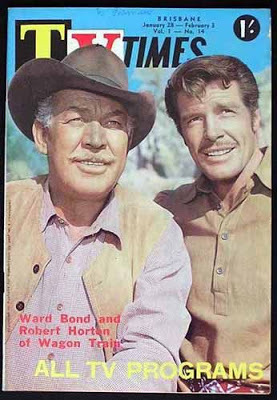 Ward Bond was wagon master Major Seth Adams, and Robert Horton was the young and charismatic buckskin-clad scout, Flint McCullough, When Horton left the show after five seasons to pursue his singing career, Robert Fuller took over as scout Cooper Smith. He would later be followed by Scott (Denny) Miller as scout Duke Shannon. When Bond died of a heart attack in the middle of the fourth season, he was replaced—without any explanation—by John McIntire, who took on the role of wagon master Christopher Hale. McIntire had guest starred in a Season 3 episode in the role of preacher Andrew Hale.
Ward Bond was wagon master Major Seth Adams, and Robert Horton was the young and charismatic buckskin-clad scout, Flint McCullough, When Horton left the show after five seasons to pursue his singing career, Robert Fuller took over as scout Cooper Smith. He would later be followed by Scott (Denny) Miller as scout Duke Shannon. When Bond died of a heart attack in the middle of the fourth season, he was replaced—without any explanation—by John McIntire, who took on the role of wagon master Christopher Hale. McIntire had guest starred in a Season 3 episode in the role of preacher Andrew Hale. 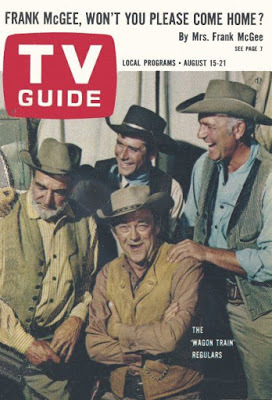 Wagon Train was able to bring in bigger guest stars than many of the other TV Westerns. This was mostly due to each episode being built around the guest star’s character and putting the proverbial spotlight directly on them.
Wagon Train was able to bring in bigger guest stars than many of the other TV Westerns. This was mostly due to each episode being built around the guest star’s character and putting the proverbial spotlight directly on them. The show was originally shot in black-and-white with location filming in Utah, Arizona, and California. When the show moved from NBC to upstart network ABC in 1962, five episodes of the show were expanded to 90 minutes and shot in color. When the ratings didn’t justify the extra cost, the length was trimmed back to 60 minutes and Wagon Train became the only show to revert back to black-and-white after being filmed in color.
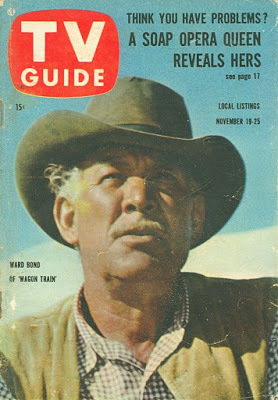 Ward Bond and Robert Horton notoriously didn’t get along. Bond was jealous over Horton receiving more fan mail and would try to limit Horton's screen time and interfere with any good lines Horton might be given in the show's scripts. This well publicized off screen friction, lent an element of realism to their scripted disputes on screen Fortunately, the pair reconciled shortly before Ward’s unexpected death.
Ward Bond and Robert Horton notoriously didn’t get along. Bond was jealous over Horton receiving more fan mail and would try to limit Horton's screen time and interfere with any good lines Horton might be given in the show's scripts. This well publicized off screen friction, lent an element of realism to their scripted disputes on screen Fortunately, the pair reconciled shortly before Ward’s unexpected death.My interest in Wagon Train surfaced again recently after watching several episodes on the nostalgia channel MeTV. This led me to track down and read the three paperback tie-in novels written by Robert Turner.
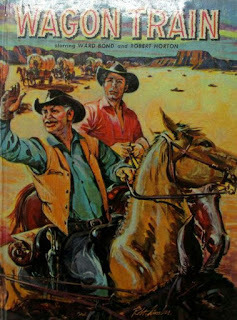 Along with the tie-in novels, Wagon Train’s popularity generated a number of other tie-ins, including the traditional items such as guns, lunch boxes, plastic action figures, a board game, the inevitable Whitman Y/A tie-in novel, and a long running series of Dell comic books.
Along with the tie-in novels, Wagon Train’s popularity generated a number of other tie-ins, including the traditional items such as guns, lunch boxes, plastic action figures, a board game, the inevitable Whitman Y/A tie-in novel, and a long running series of Dell comic books.The show was also popular in England where it generated a series of traditional annuals—Christmas time publications tied to popular shows and other pop culture icons, which made easy gifts for nephews and nieces.
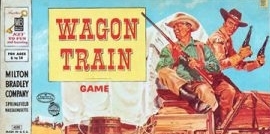
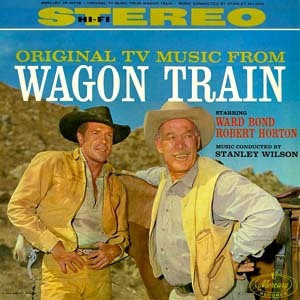
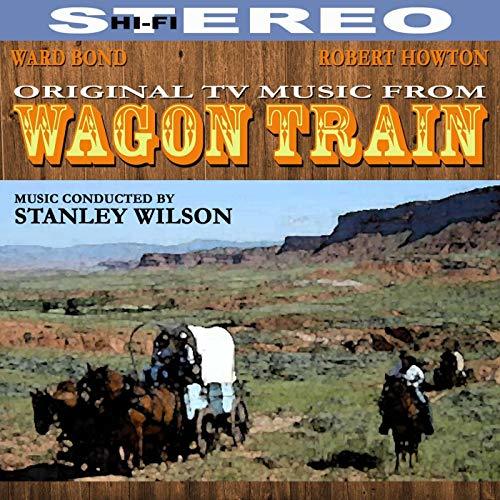
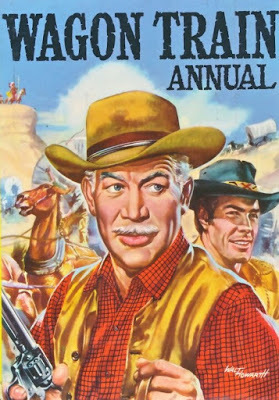
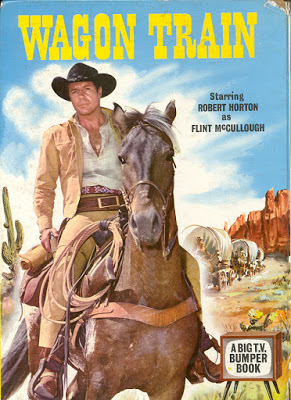
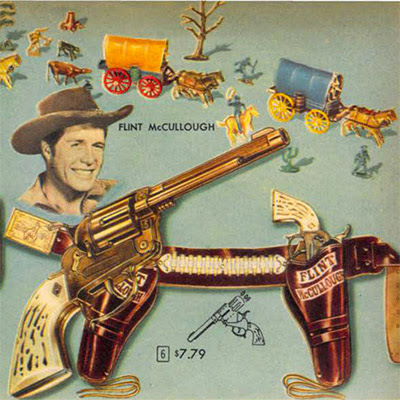
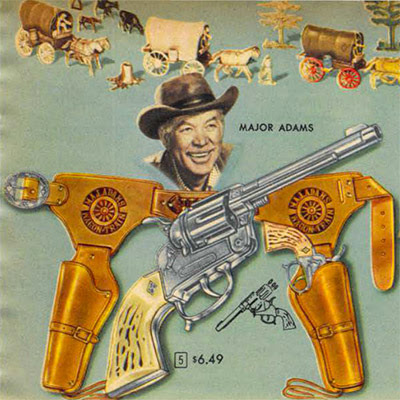
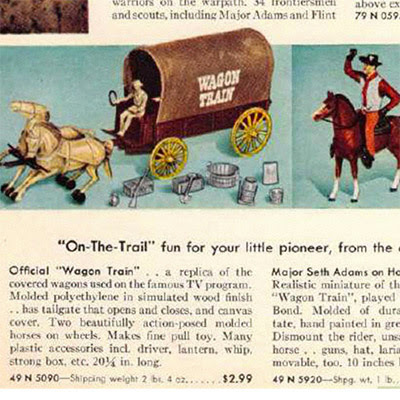
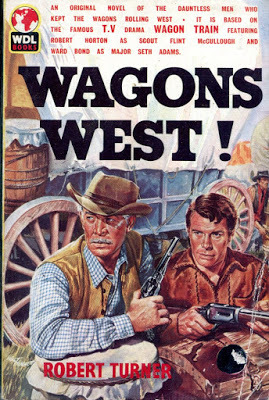
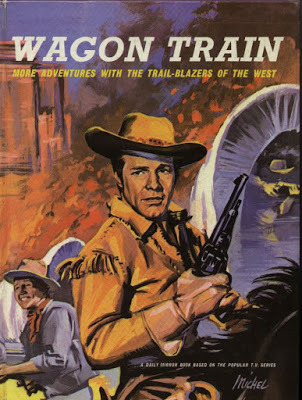
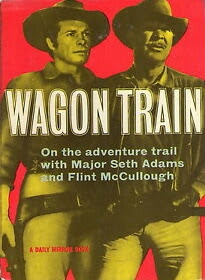
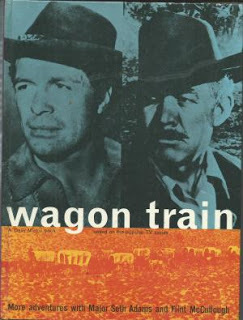
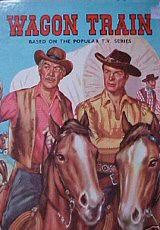
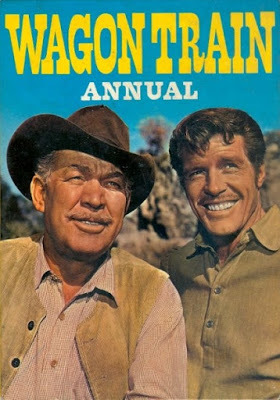
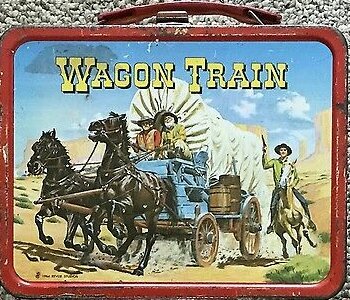
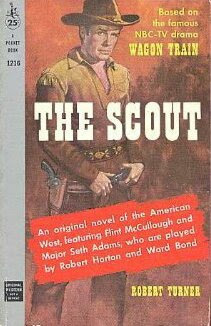
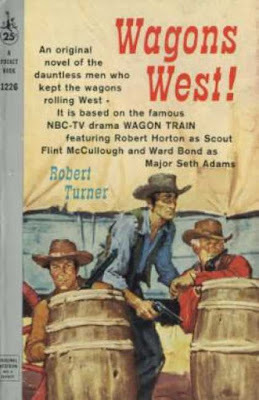
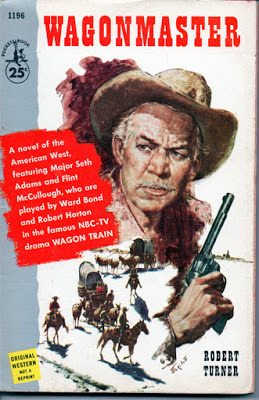
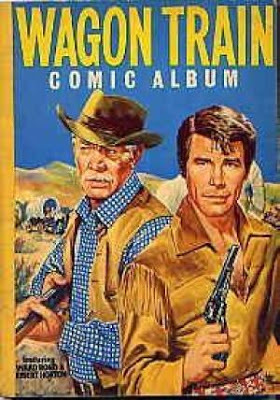
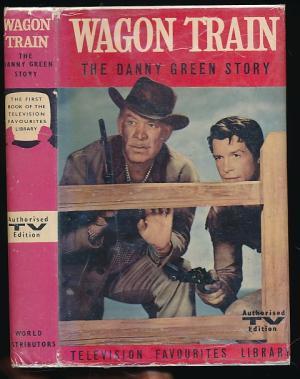
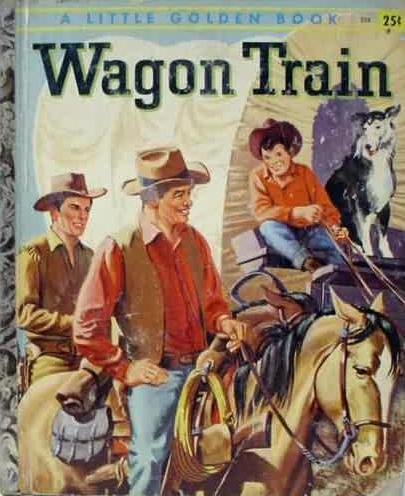
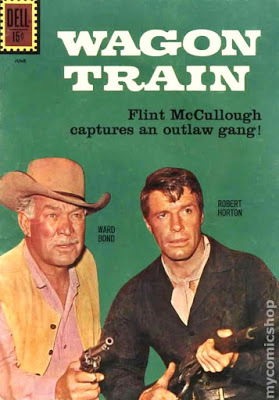
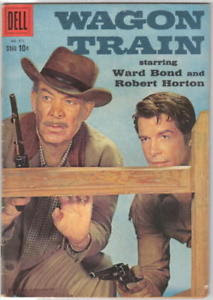
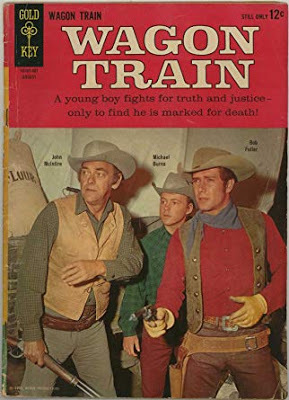
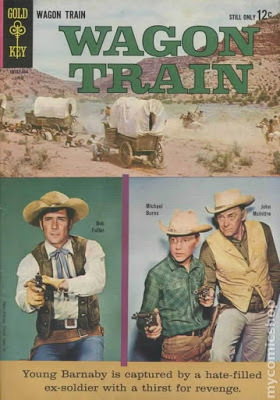
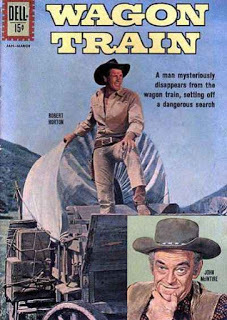
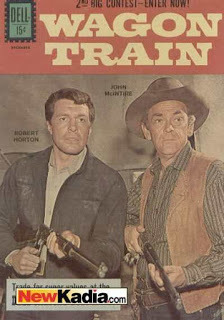
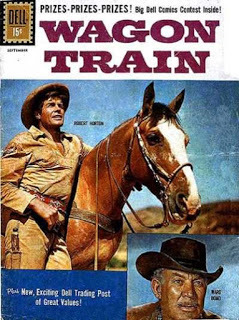
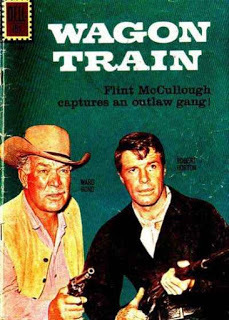
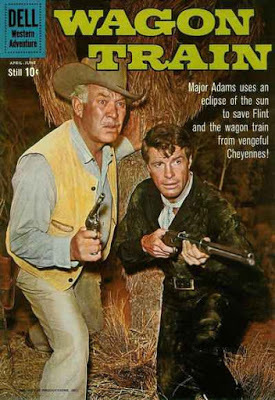
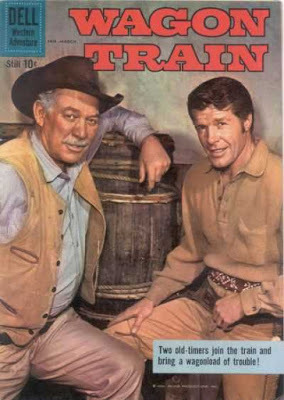
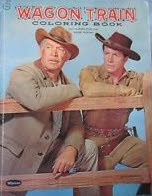
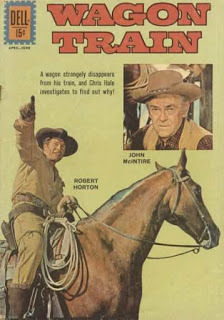
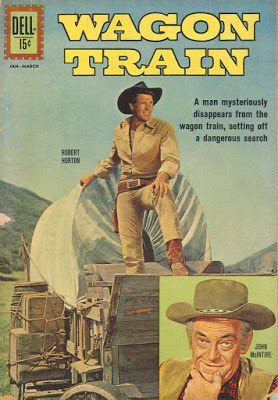
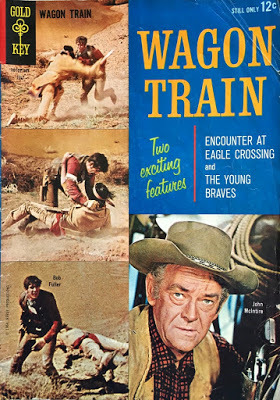
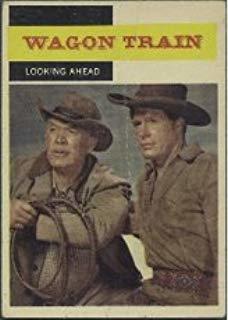
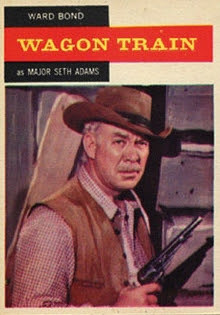
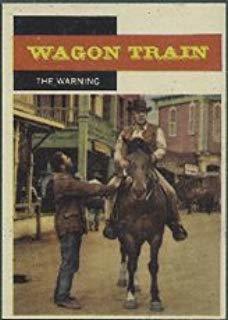
Published on September 25, 2019 15:53
September 23, 2019
52 WEEKS • 52 WESTERNS SERIES
 52 WEEKS • 52 WESTERNS SERIES Over the past three years, I've been immersed in Western novels, movies, and TV shows while compiling the three related books in the 52 Weeks • 52 Westerns series (novels, movies, and TV shows), which I complied with my compadre Scott Harris. Because of the variety of individual reminiscences about what the included Western novels, movies, and TV shows meant personally to the wide range of owlhoots who rode the trail with us, we believe these compilations are unique and stand out from other Western reference works.
52 WEEKS • 52 WESTERNS SERIES Over the past three years, I've been immersed in Western novels, movies, and TV shows while compiling the three related books in the 52 Weeks • 52 Westerns series (novels, movies, and TV shows), which I complied with my compadre Scott Harris. Because of the variety of individual reminiscences about what the included Western novels, movies, and TV shows meant personally to the wide range of owlhoots who rode the trail with us, we believe these compilations are unique and stand out from other Western reference works. 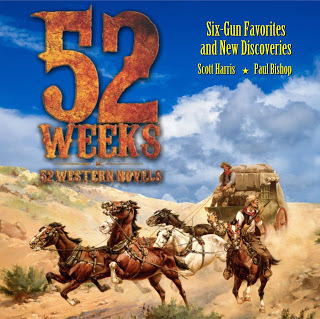 52 WEEKS • 52 WESTERN NOVELS The Wild West is uniquely American. It is a legend brought to life in sagas of blazing six-gun justice in wide-open towns and across vast ranges. 52 Weeks • 52 Western Novels is a fun guide to some of the best of these Western tales. Step into the Wild West, ride dusty trails, slap leather with outlaws, and get ready to battle Indians and the elements--all from the comfort of your favorite reading spot.
52 WEEKS • 52 WESTERN NOVELS The Wild West is uniquely American. It is a legend brought to life in sagas of blazing six-gun justice in wide-open towns and across vast ranges. 52 Weeks • 52 Western Novels is a fun guide to some of the best of these Western tales. Step into the Wild West, ride dusty trails, slap leather with outlaws, and get ready to battle Indians and the elements--all from the comfort of your favorite reading spot. 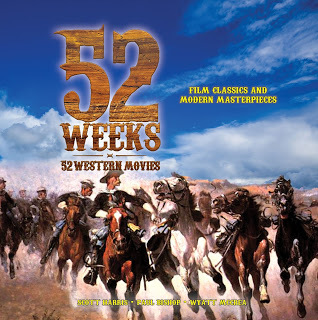 52 WEEKS • 52 WESTERN MOVIES The Wild West of the silver screen is indelibly embedded in the soul of America. From silent movies to singing cowboys, from Saturday morning matinee serials to the tension of High Noon and 3:10 to Yuma, from John Wayne to Joel McCrea to Audie Murphy to Randolph Scott to Glenn Ford and so many others, from The Searchers to The Professionals to The Magnificent Sevens to the True Grits to The Good, The Bad and the Ugly to The Unforgiven to Dances With Wolves and other horse opera Oscar winners-- the Western has done it all. 52 Weeks • 52 Western Movies is a fun guide to classics of the genre and overlooked gems deserving of wider recognition. So grab your boots and saddles, and posse up with us to ride across celluloid landscapes and open ranges West of the imagination...
52 WEEKS • 52 WESTERN MOVIES The Wild West of the silver screen is indelibly embedded in the soul of America. From silent movies to singing cowboys, from Saturday morning matinee serials to the tension of High Noon and 3:10 to Yuma, from John Wayne to Joel McCrea to Audie Murphy to Randolph Scott to Glenn Ford and so many others, from The Searchers to The Professionals to The Magnificent Sevens to the True Grits to The Good, The Bad and the Ugly to The Unforgiven to Dances With Wolves and other horse opera Oscar winners-- the Western has done it all. 52 Weeks • 52 Western Movies is a fun guide to classics of the genre and overlooked gems deserving of wider recognition. So grab your boots and saddles, and posse up with us to ride across celluloid landscapes and open ranges West of the imagination... 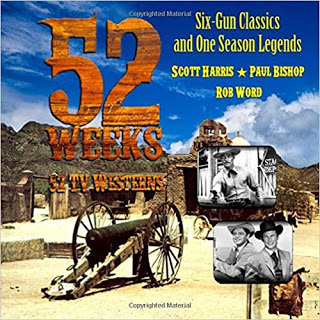 52 WEEKS • 52 TV WESTERNS For three decades Westerns dominated American television, so much so it was sometimes tough to find any non-Western programming on the three major networks—ABC, CBS, and NBC. There were breakout shows such as Gunsmoke, Wagon Train, Bonanza, the Virginian, and others we remember fondly. Dad, mom, and kids alike, gathered together around televisions across the country and welcomed lawmen, drifting cowboys, fictionalized versions of Wild West icons into our homes as if they were family. There were also breakout stars like Steve McQueen, Richard Boone, Chuck Conners, James Garner, and James Arness who wore their six-guns and cowboy hats, and rode their horses down dusty trails to superstardom. 52 Weeks • 52 TV Westerns is a fun guide designed to renew our acquaintance with the classics Western shows we loved. The spotlight also falls on Western series gems we might have missed, but can now track down on cable channels devoted to classic Westerns, or binge watch on DVD. So saddle up, and as Steve McQueen in his role of bounty hunter Josh Randall in Wanted: Dead or Alive repeatedly said, “Let's go...”
52 WEEKS • 52 TV WESTERNS For three decades Westerns dominated American television, so much so it was sometimes tough to find any non-Western programming on the three major networks—ABC, CBS, and NBC. There were breakout shows such as Gunsmoke, Wagon Train, Bonanza, the Virginian, and others we remember fondly. Dad, mom, and kids alike, gathered together around televisions across the country and welcomed lawmen, drifting cowboys, fictionalized versions of Wild West icons into our homes as if they were family. There were also breakout stars like Steve McQueen, Richard Boone, Chuck Conners, James Garner, and James Arness who wore their six-guns and cowboy hats, and rode their horses down dusty trails to superstardom. 52 Weeks • 52 TV Westerns is a fun guide designed to renew our acquaintance with the classics Western shows we loved. The spotlight also falls on Western series gems we might have missed, but can now track down on cable channels devoted to classic Westerns, or binge watch on DVD. So saddle up, and as Steve McQueen in his role of bounty hunter Josh Randall in Wanted: Dead or Alive repeatedly said, “Let's go...” HOT LEAD My love of vintage Westerns also drew me to contribute and act in an advisory capacity to the full color fanzine Hot Lead, edited and published by my wordslinging amigo, Justin Marriott.
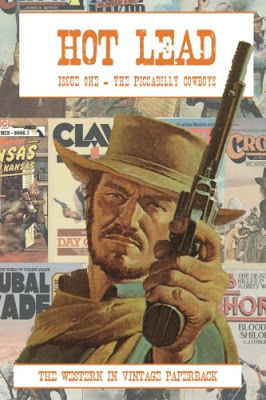
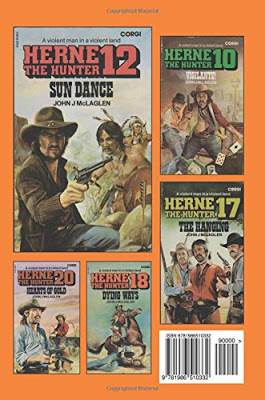 HOT LEAD ISSUE #1 The fanzine of vintage western paperbacks. 60 pages full color. Debut issue traces the Piccadilly Cowboys phenomenon, with reviews, articles and interviews on the controversial western paperbacks perhaps best typified by the George Gilman Edge series.
HOT LEAD ISSUE #1 The fanzine of vintage western paperbacks. 60 pages full color. Debut issue traces the Piccadilly Cowboys phenomenon, with reviews, articles and interviews on the controversial western paperbacks perhaps best typified by the George Gilman Edge series. 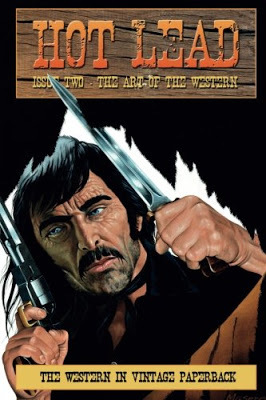
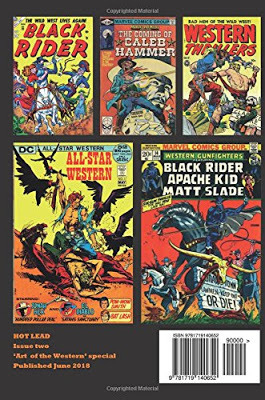 HOT LEAD ISSUE #2 The western in vintage paperback. 68 pages, full colour. "Art of the Western" special. Includes an interview with Tony Masero accompanied by original art, articles on western comic books, Charro! the movie tie-in, Euro Western series Ronco and the comic art of Frank Bellamy.
HOT LEAD ISSUE #2 The western in vintage paperback. 68 pages, full colour. "Art of the Western" special. Includes an interview with Tony Masero accompanied by original art, articles on western comic books, Charro! the movie tie-in, Euro Western series Ronco and the comic art of Frank Bellamy. 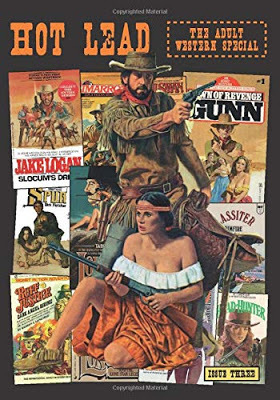
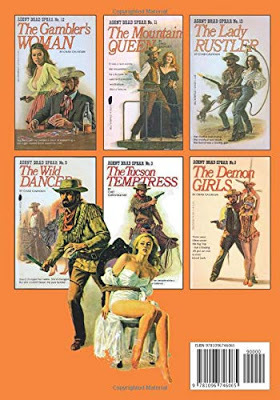 HOT LEAD ISSUE #3 The fanzine devoted to vintage western paperbacks. 52 pages, full color throughout. A special devoted to the 'adult western; typified by series such as Slocum, Longarm and The Gunsmith. Includes a history of the genre plus articles on key series. Packed with reproductions of the paperback covers. A must for the western reader!
HOT LEAD ISSUE #3 The fanzine devoted to vintage western paperbacks. 52 pages, full color throughout. A special devoted to the 'adult western; typified by series such as Slocum, Longarm and The Gunsmith. Includes a history of the genre plus articles on key series. Packed with reproductions of the paperback covers. A must for the western reader! HEAD WEST A couple of other trail pard's Ben Bridges and Mike Stoddard. Have also publish two issues of another Western fanzine to which I have contributed, which are also worth tracking down for fans of the genre.
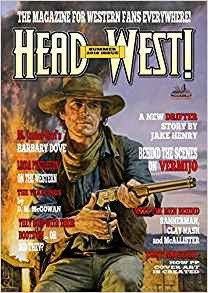 HEAD WEST ISSUE #1 The first issue of Piccadilly Publishing's new western-themed magazine, Head West! contains something for all lovers of the genre! Edited by Ben Bridges, there are interviews by David Whitehead, a feature on creating Piccadilly Publishing covers by artist supreme Tony Masero, a personal take on the western by Linda Pendleton, a behind-the-scenes look at Piccadilly Publishing's first western movie, Vermijo, by director Paul Vernon, and fiction from the likes of Jake Henry, D. M. McGowan and M. James Earl. Fully illustrated throughout, this is sure to become a collector's item!
HEAD WEST ISSUE #1 The first issue of Piccadilly Publishing's new western-themed magazine, Head West! contains something for all lovers of the genre! Edited by Ben Bridges, there are interviews by David Whitehead, a feature on creating Piccadilly Publishing covers by artist supreme Tony Masero, a personal take on the western by Linda Pendleton, a behind-the-scenes look at Piccadilly Publishing's first western movie, Vermijo, by director Paul Vernon, and fiction from the likes of Jake Henry, D. M. McGowan and M. James Earl. Fully illustrated throughout, this is sure to become a collector's item! 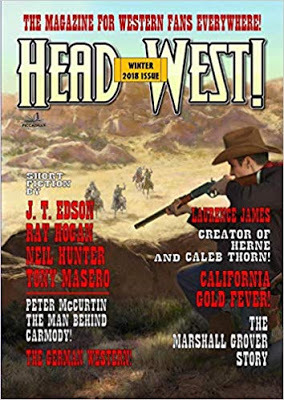 HEAD WEST ISSUE#2 Issue Two of Piccadilly Publishing's Head West! magazine contains a variety of articles, features and stories devoted to the western genre. We have fiction from J T Edson, Ray Hogan, Neil Hunter and Tony Masero, a look at the western genre in Germany, courtesy of Alfred Wallon, Linda Pendleton's intriguing history of the California Gold Rush, plus author profiles of Laurence James, Peter McCurtin and Marshall Grover. Over 100 pages, fully illustrated throughout. It's a magazine no serious western fan can be without!
HEAD WEST ISSUE#2 Issue Two of Piccadilly Publishing's Head West! magazine contains a variety of articles, features and stories devoted to the western genre. We have fiction from J T Edson, Ray Hogan, Neil Hunter and Tony Masero, a look at the western genre in Germany, courtesy of Alfred Wallon, Linda Pendleton's intriguing history of the California Gold Rush, plus author profiles of Laurence James, Peter McCurtin and Marshall Grover. Over 100 pages, fully illustrated throughout. It's a magazine no serious western fan can be without!
Published on September 23, 2019 12:07
September 22, 2019
FORGOTTEN TV WESTERNS—ANNIE OAKLEY
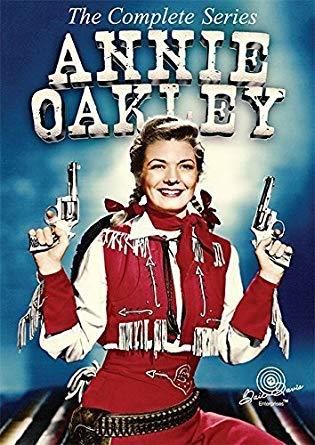 FORGOTTEN TV WESTERNS
FORGOTTEN TV WESTERNSANNIE OAKLEY Cast as Annie Oakley in 1953, Gail Davis became TV’s first female heroine. It was a role the then 27 year old actress would be associated with for the rest of her life—in much the same way as Clayton Moore was linked with The Lone Ranger.
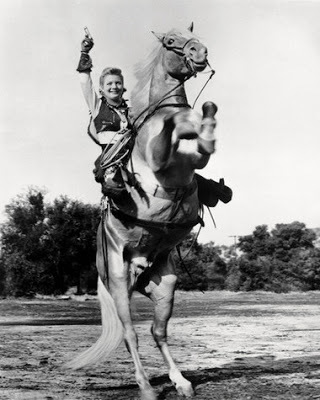 Gene Autry's Flying-A Productions produced the half hour episodes of Annie Oakley, which ran in syndication across the nation. Alongside deputy sheriff Lofty Craig (Johnson)—considered her silent suitor—and her kid brother, Tagg (Hawkins), the five-foot-two, 95 pounds, and cute as a button Annie was a crack shot and the scourge of badmen who dared show their bandana-covered faces in her mythical hometown, of Diablo, AZ.
Gene Autry's Flying-A Productions produced the half hour episodes of Annie Oakley, which ran in syndication across the nation. Alongside deputy sheriff Lofty Craig (Johnson)—considered her silent suitor—and her kid brother, Tagg (Hawkins), the five-foot-two, 95 pounds, and cute as a button Annie was a crack shot and the scourge of badmen who dared show their bandana-covered faces in her mythical hometown, of Diablo, AZ.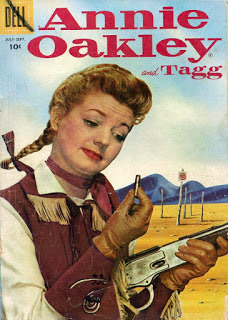 Deputy Craig handled all the fisticuffs, but it was the sharpshooting Annie who saved the day—often rescuing the mischievously annoying Tagg in the process. As for parents who might be concerned by her exploits, in one episode Annie refers to her mother’s death, but there was no mention of her mysteriously absent father.
Deputy Craig handled all the fisticuffs, but it was the sharpshooting Annie who saved the day—often rescuing the mischievously annoying Tagg in the process. As for parents who might be concerned by her exploits, in one episode Annie refers to her mother’s death, but there was no mention of her mysteriously absent father. 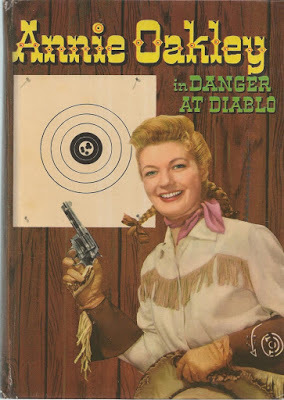 Davis had previously co-starred with Gene Autry in 14 features, but was not originally considered to play the historically iconic female sharpshooter. Autry and executive producer Armand Schaefer auditioned girls who could ride, and girls who could shoot, but they couldn’t find a girl who could do both, not realizing she was right there under their noses. Up until her death in 1997, Davis never stopped being Annie Oakley, visiting kids in hospitals and other venues everywhere. Target, Annie’s horse, was played by three similarly colored Palominos. Tagg’s horse was Pixie.
Davis had previously co-starred with Gene Autry in 14 features, but was not originally considered to play the historically iconic female sharpshooter. Autry and executive producer Armand Schaefer auditioned girls who could ride, and girls who could shoot, but they couldn’t find a girl who could do both, not realizing she was right there under their noses. Up until her death in 1997, Davis never stopped being Annie Oakley, visiting kids in hospitals and other venues everywhere. Target, Annie’s horse, was played by three similarly colored Palominos. Tagg’s horse was Pixie. 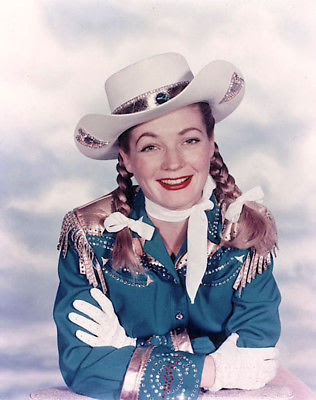 Each episode opened with Annie shooting a neat hole in the center of a nine of spades playing card, being held up by Lofty, while standing upright on the saddle of her trusty Palomino Target, who is galloping at top speed. For a kid there wasn’t anything more thrilling.
Each episode opened with Annie shooting a neat hole in the center of a nine of spades playing card, being held up by Lofty, while standing upright on the saddle of her trusty Palomino Target, who is galloping at top speed. For a kid there wasn’t anything more thrilling.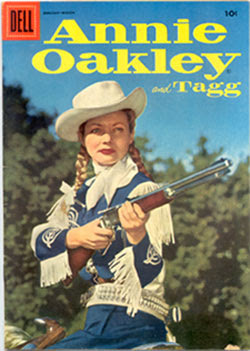 In the pilot episode for the series, Bull's Eye, Billy Gray played Tagg, but quickly moved on when the pilot didn’t sell and he was offered the role as James BudAnderson, Jr. on television’s Father Knows Best. Also in the original pilot, Annie’s uncle was Sheriff Luke McTavish (Kenneth MacDonald), who was always conveniently out of town when trouble came.
In the pilot episode for the series, Bull's Eye, Billy Gray played Tagg, but quickly moved on when the pilot didn’t sell and he was offered the role as James BudAnderson, Jr. on television’s Father Knows Best. Also in the original pilot, Annie’s uncle was Sheriff Luke McTavish (Kenneth MacDonald), who was always conveniently out of town when trouble came. 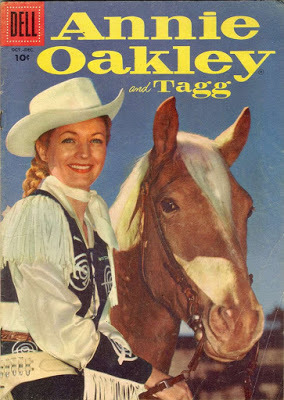 Convinced he had a great concept, Gene Autry order a second pilot, Annie Gets Her Man, to be shot. This time the episode had more action oriented and less saccharine. This time the show sold and the series went on to huge popularity. Annie Oakley was a show like The Lone Ranger, which the whole family could enjoy. A girl who could out shoot and out ride any male, however, gave a whole generation of girls their first taste of female empowerment.
Convinced he had a great concept, Gene Autry order a second pilot, Annie Gets Her Man, to be shot. This time the episode had more action oriented and less saccharine. This time the show sold and the series went on to huge popularity. Annie Oakley was a show like The Lone Ranger, which the whole family could enjoy. A girl who could out shoot and out ride any male, however, gave a whole generation of girls their first taste of female empowerment. 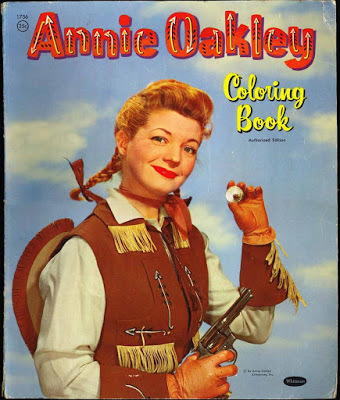 The show was affectionately referred to as Pigtails and Pistols due to the pigtailedhairstyle sported by Gail Davis as Annie. Davis was usually doubled by Donna Hall or Alice Van. However, Davis’ best friend and look-alike, actress Nan Leslie, filled in for one episode after Davis broke her ankle stepping off a curb.
The show was affectionately referred to as Pigtails and Pistols due to the pigtailedhairstyle sported by Gail Davis as Annie. Davis was usually doubled by Donna Hall or Alice Van. However, Davis’ best friend and look-alike, actress Nan Leslie, filled in for one episode after Davis broke her ankle stepping off a curb.Annie Oakley collectibles were extensive. Everything from Dell comic books to BB rifles to holster sets, puzzles, and much more were all available. In 1955, at the height of the show’s popularity, officially licensed Annie Oakley merchandise topped $10,000,000 in sales.
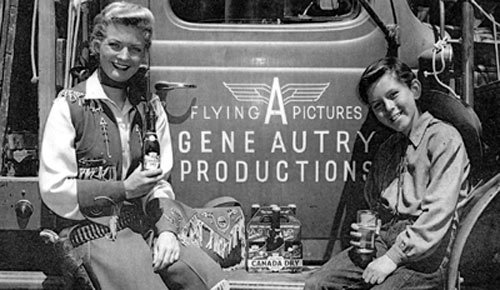
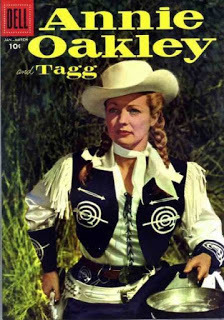
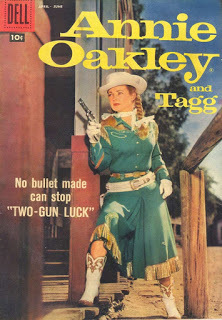
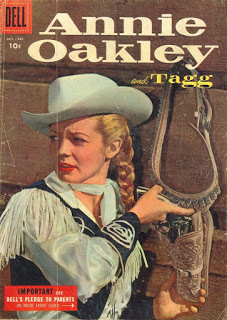
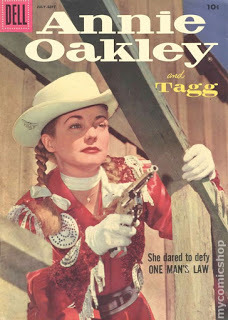
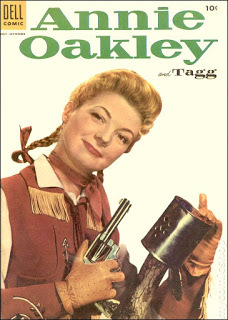
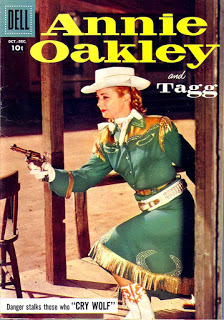
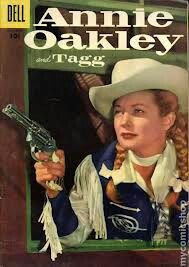
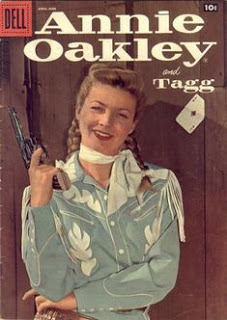
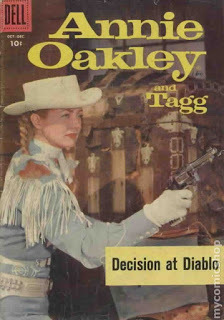
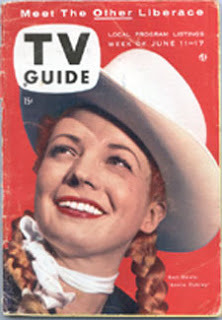
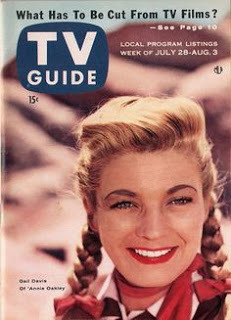
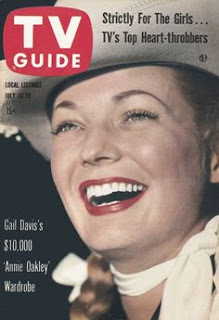
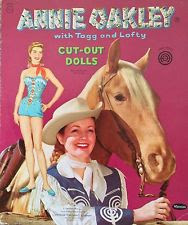
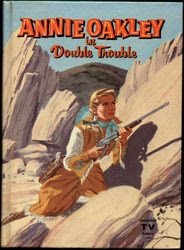
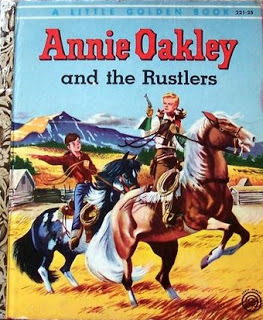
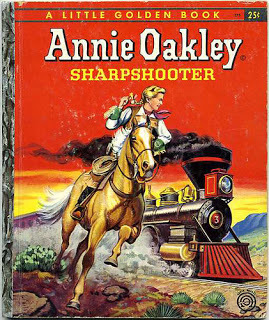
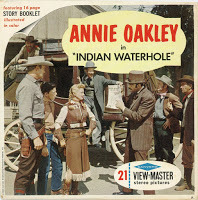
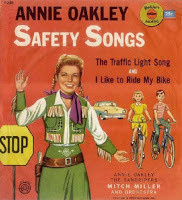
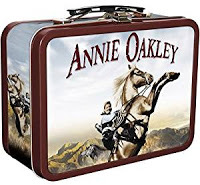
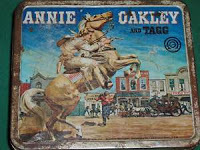
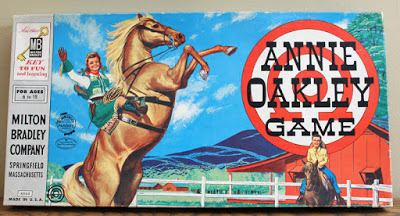
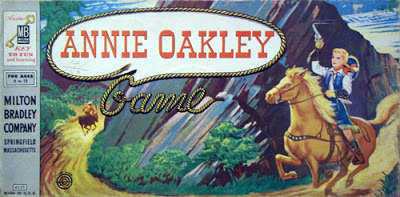
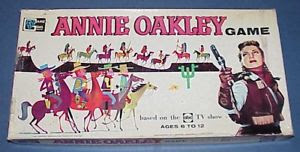
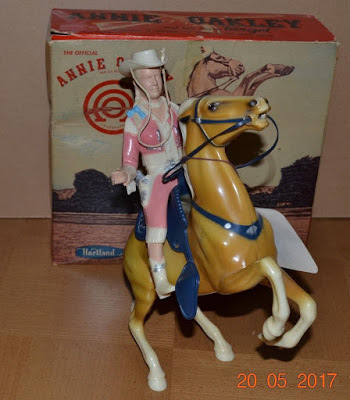
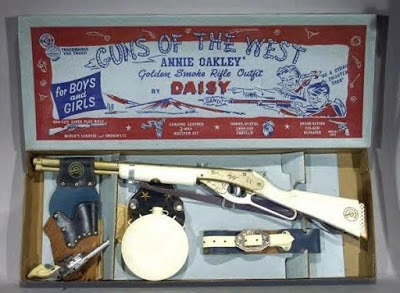
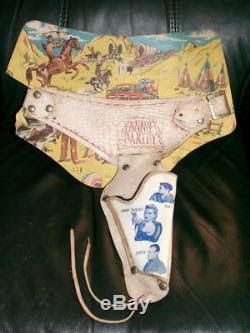
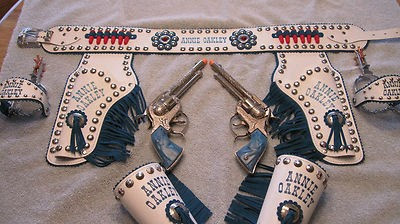
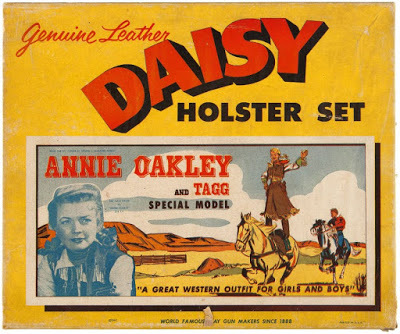
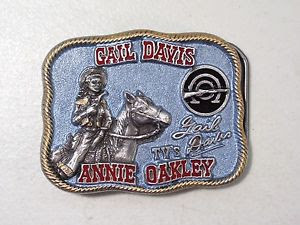
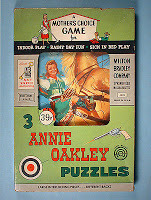
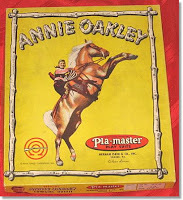
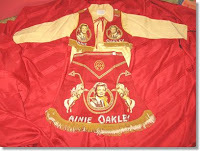
Published on September 22, 2019 23:49
FORGOTTEN WESTERNS—JOHNNY CONCHO
 FORGOTTEN WESTERNS
FORGOTTEN WESTERNSJOHNNY CONCHONever heard of Johnny Concho? If so, you're probably better off. Coming off a year when he starred in four hit movies, Johnny Concho was Sinatra' s first Western. The film was directed by Don McGuire and co-starred Keenan Wynn, William Conrad, and Phyllis Kirk.
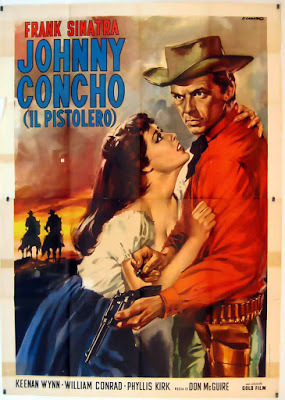 Johnny Concho debuted in 1956, the same year Sinatra had a big hit wuth the title role in High Society. Sinatra had also appeared in four successful films the year before.
Johnny Concho debuted in 1956, the same year Sinatra had a big hit wuth the title role in High Society. Sinatra had also appeared in four successful films the year before. 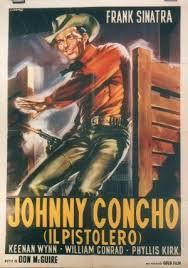 However, despite the high profile popularity of his other audience pleasing flicks, the reaction to Johnny Concho was lukewarm at best. Nobody wanted to see Sinatra playing the role of a coward for almost the entire film. People wanted Sinatra the singer and dancer. It would take another decade before folks would pay money at the ticket booth to see Sinatra the actor.
However, despite the high profile popularity of his other audience pleasing flicks, the reaction to Johnny Concho was lukewarm at best. Nobody wanted to see Sinatra playing the role of a coward for almost the entire film. People wanted Sinatra the singer and dancer. It would take another decade before folks would pay money at the ticket booth to see Sinatra the actor.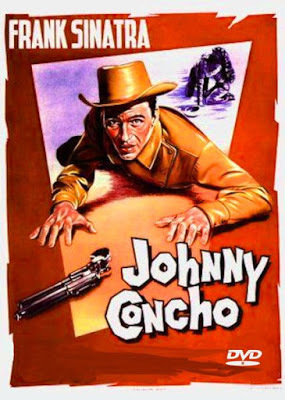 The people of Cripple Creek fear the mean, petty and boastful Johnny Concho (a role Sinatra was born to play), but only because his brother is a notorious gunfighter. Johnny takes advantage of his position, bullying the townsfolk, until the arrival of a cowboy named Tallman (William Conrad). Tallman claims to have killed Johnny' s brother and, after exposing Johnny as a coward, takes over the town. Tallman, however, is more hated than Johnny. Johnny must now gain the courage to fight Tallman, earn the respect of Cripple Creek's townsfolk, and win the heart of Mary, the general store owner's daughter.
The people of Cripple Creek fear the mean, petty and boastful Johnny Concho (a role Sinatra was born to play), but only because his brother is a notorious gunfighter. Johnny takes advantage of his position, bullying the townsfolk, until the arrival of a cowboy named Tallman (William Conrad). Tallman claims to have killed Johnny' s brother and, after exposing Johnny as a coward, takes over the town. Tallman, however, is more hated than Johnny. Johnny must now gain the courage to fight Tallman, earn the respect of Cripple Creek's townsfolk, and win the heart of Mary, the general store owner's daughter.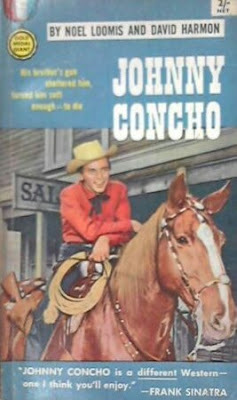 The movie was written by David Harmon, based on his story, The Man Who Owned the Town. Harmon was a prolific writer for numerous episodic television series, but Johnny Concho was his sole movie credit.
The movie was written by David Harmon, based on his story, The Man Who Owned the Town. Harmon was a prolific writer for numerous episodic television series, but Johnny Concho was his sole movie credit. Perhaps anticipating a more positive audience response to the film, Gold Medal published a paperback tie-in novelization with a photo of a horse-sitting Sinatra on the cover looking like a cowboy who could be knocked over by a fast moving tumbleweed.
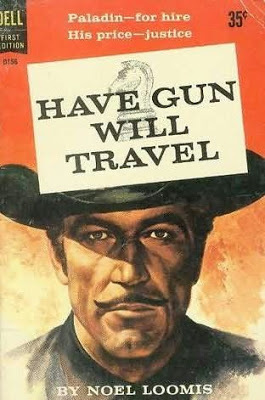 Noel Loomis, a well respected Western wordslinger and science fiction novelist, was given sole credit for the novelization on the cover of the American publication. The British tie-in edition, however, used the same movie still of sinatra on the cover, but also gave credit to Johnny Concho screenwriter David Harmon alongside Loomis.
Noel Loomis, a well respected Western wordslinger and science fiction novelist, was given sole credit for the novelization on the cover of the American publication. The British tie-in edition, however, used the same movie still of sinatra on the cover, but also gave credit to Johnny Concho screenwriter David Harmon alongside Loomis. 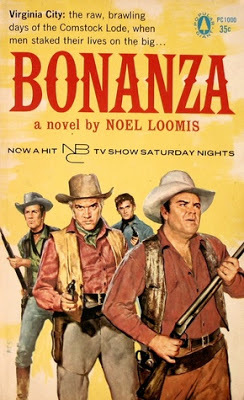 During his career, Noel Loomis also wrote the scripts for episodes of Have Gun Will Travel, Bonanza, and Cheyenne. Those gigs led to him writing original tie-in novels for Have Gun Will Travel and Bonanza. It's too bad he didn't also get the chance to do an original Cheyenne tie-in novel.
During his career, Noel Loomis also wrote the scripts for episodes of Have Gun Will Travel, Bonanza, and Cheyenne. Those gigs led to him writing original tie-in novels for Have Gun Will Travel and Bonanza. It's too bad he didn't also get the chance to do an original Cheyenne tie-in novel.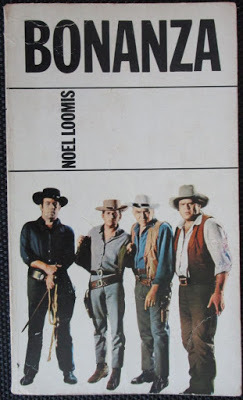
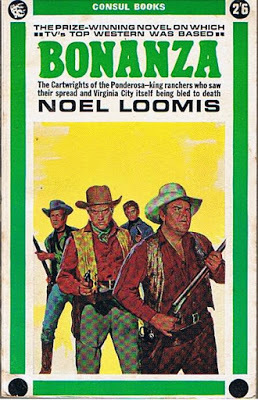

Published on September 22, 2019 08:22
JOHNNY CONCHO
 JOHNNY CONCHONever heard of Johnny Concho? If so, you're probably better off. Coming off a year when he starred in four hit movies, Johnny Concho was Sinatra' s first Western. The film was directed by Don McGuire and co-starred Keenan Wynn, William Conrad, and Phyllis Kirk.
JOHNNY CONCHONever heard of Johnny Concho? If so, you're probably better off. Coming off a year when he starred in four hit movies, Johnny Concho was Sinatra' s first Western. The film was directed by Don McGuire and co-starred Keenan Wynn, William Conrad, and Phyllis Kirk. Johnny Concho debuted in 1956, the same year Sinatra had a big hit wuth the title role in High Society. Sinatra had also appeared in four successful films the year before.
Johnny Concho debuted in 1956, the same year Sinatra had a big hit wuth the title role in High Society. Sinatra had also appeared in four successful films the year before.  However, despite the high profile popularity of his other audience pleasing flicks, the reaction to Johnny Concho was lukewarm at best. Nobody wanted to see Sinatra playing the role of a coward for almost the entire film. People wanted Sinatra the singer and dancer. It would take another decade before folks would pay money at the ticket booth to see Sinatra the actor.
However, despite the high profile popularity of his other audience pleasing flicks, the reaction to Johnny Concho was lukewarm at best. Nobody wanted to see Sinatra playing the role of a coward for almost the entire film. People wanted Sinatra the singer and dancer. It would take another decade before folks would pay money at the ticket booth to see Sinatra the actor. The people of Cripple Creek fear the mean, petty and boastful Johnny Concho (a role Sinatra was born to play), but only because his brother is a notorious gunfighter. Johnny takes advantage of his position, bullying the townsfolk, until the arrival of a cowboy named Tallman (William Conrad). Tallman claims to have killed Johnny' s brother and, after exposing Johnny as a coward, takes over the town. Tallman, however, is more hated than Johnny. Johnny must now gain the courage to fight Tallman, earn the respect of Cripple Creek's townsfolk, and win the heart of Mary, the general store owner's daughter.
The people of Cripple Creek fear the mean, petty and boastful Johnny Concho (a role Sinatra was born to play), but only because his brother is a notorious gunfighter. Johnny takes advantage of his position, bullying the townsfolk, until the arrival of a cowboy named Tallman (William Conrad). Tallman claims to have killed Johnny' s brother and, after exposing Johnny as a coward, takes over the town. Tallman, however, is more hated than Johnny. Johnny must now gain the courage to fight Tallman, earn the respect of Cripple Creek's townsfolk, and win the heart of Mary, the general store owner's daughter. The movie was written by David Harmon, based on his story, The Man Who Owned the Town. Harmon was a prolific writer for numerous episodic television series, but Johnny Concho was his sole movie credit.
The movie was written by David Harmon, based on his story, The Man Who Owned the Town. Harmon was a prolific writer for numerous episodic television series, but Johnny Concho was his sole movie credit. Perhaps anticipating a more positive audience response to the film, Gold Medal published a paperback tie-in novelization with a photo of a horse-sitting Sinatra on the cover looking like a cowboy who could be knocked over by a fast moving tumbleweed.
 Noel Loomis, a well respected Western wordslinger and science fiction novelist, was given sole credit for the novelization on the cover of the American publication. The British tie-in edition, however, used the same movie still of sinatra on the cover, but also gave credit to Johnny Concho screenwriter David Harmon alongside Loomis.
Noel Loomis, a well respected Western wordslinger and science fiction novelist, was given sole credit for the novelization on the cover of the American publication. The British tie-in edition, however, used the same movie still of sinatra on the cover, but also gave credit to Johnny Concho screenwriter David Harmon alongside Loomis.  During his career, Noel Loomis also wrote the scripts for episodes of Have Gun Will Travel, Bonanza, and Cheyenne. Those gigs led to him writing original tie-in novels for Have Gun Will Travel and Bonanza. It's too bad he didn't also get the chance to do an original Cheyenne tie-in novel.
During his career, Noel Loomis also wrote the scripts for episodes of Have Gun Will Travel, Bonanza, and Cheyenne. Those gigs led to him writing original tie-in novels for Have Gun Will Travel and Bonanza. It's too bad he didn't also get the chance to do an original Cheyenne tie-in novel.


Published on September 22, 2019 08:22
September 19, 2019
PROFESSOR T.
 PROFESSOR T. Currently airing in America on many PBS channels, Professor T is a Sherlock Holmes/Monk mash-up. I was skeptical at first, but Professor T has rapidly become my favorite foreign language series alongside HBO Asia’s Miss Sherlock.
PROFESSOR T. Currently airing in America on many PBS channels, Professor T is a Sherlock Holmes/Monk mash-up. I was skeptical at first, but Professor T has rapidly become my favorite foreign language series alongside HBO Asia’s Miss Sherlock. The version of Professor T being shown in America is the original series made in Belgium, which has so far run for 39 episodes over three seasons beginning in 2015. This original proved so popular with viewers it has spawned versions in France, Germany, and the Czech Republic. There are also rumors of an American version coming soon.
While the character of a brilliant, eccentric, germaphobic, police consultant with no social skills has become a well-worn cliché, there is something inherent in the setup that continues to appeal to us through its many and various incarnations. Professor Tis but one more notch on the Sherlockian calabash, however, after two episodes it does become addictive, binge worthy viewing.
If you watch the series in any of its manifestations be aware it takes a while to get used to the scenes where Professor T's imaginations flow briefly into reality before returning to the here and now.
 BELGIUM In the original series, eccentric professor and criminologist Jasper Teerlinck (Koen De Bouw) known to his students and colleagues as Professor T, has a brilliant mind and more than a few neurological disorders. Rude and insulting, he appears to delight in targeting an individual’s weak spots. Often, he gives the impression he doesn’t understand how or why people get upset with him, nor does he care. But there are other instances when he consciously uses his anti-social traits to his advantage. In his role as a police consultant, he is—of course—always right, which frustrates those individuals who would much prefer to see him banished from the squad room.
BELGIUM In the original series, eccentric professor and criminologist Jasper Teerlinck (Koen De Bouw) known to his students and colleagues as Professor T, has a brilliant mind and more than a few neurological disorders. Rude and insulting, he appears to delight in targeting an individual’s weak spots. Often, he gives the impression he doesn’t understand how or why people get upset with him, nor does he care. But there are other instances when he consciously uses his anti-social traits to his advantage. In his role as a police consultant, he is—of course—always right, which frustrates those individuals who would much prefer to see him banished from the squad room. 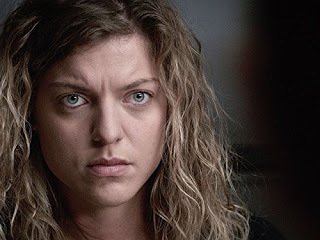 Working with Professor T are Inspectors Annelies Donckers (Ella Leyers) and Daan De Winter (Bart Hollanders). She is the explosive one. He is the quiet behind-the-scenes operator. Having once been Professor T’s students at the university, they know how to ignore his shortcomings and how best to handle him.
Working with Professor T are Inspectors Annelies Donckers (Ella Leyers) and Daan De Winter (Bart Hollanders). She is the explosive one. He is the quiet behind-the-scenes operator. Having once been Professor T’s students at the university, they know how to ignore his shortcomings and how best to handle him.
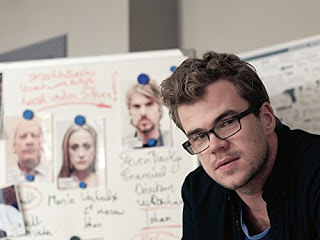 Commissioner Paul Rabe (Herwig Ilegems) disapproves of Professor T and feels left out. Head of the criminal investigation department, Christina Flamant (Tanja Oostvogels) considers Professor T's collaboration with mixed feelings because they were once a couple.
Commissioner Paul Rabe (Herwig Ilegems) disapproves of Professor T and feels left out. Head of the criminal investigation department, Christina Flamant (Tanja Oostvogels) considers Professor T's collaboration with mixed feelings because they were once a couple.  FRANCE Known as Prof T, the French remake of the original Belgium series curiously didn’t air in France until a year after it premiered in Belgium. Despite the slight name change, Prof T (Mathieu Bisson) is the same brilliant neurological mess.
FRANCE Known as Prof T, the French remake of the original Belgium series curiously didn’t air in France until a year after it premiered in Belgium. Despite the slight name change, Prof T (Mathieu Bisson) is the same brilliant neurological mess. 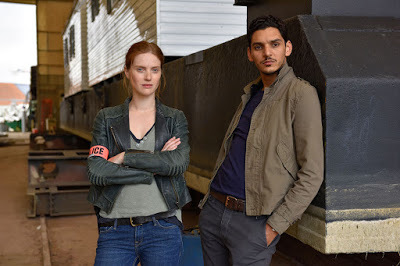 Inspectors Lise Doumère (Fleur Geffrier) and Dan Levasseur (Amir El Kacem) work with Prof T, trying to keep his anti-social tendencies from getting completely out of hand. Commissioner Paul Rabet (Pierre Berriau) still disapproves, and Commissaire Flamand (Zoé Félix) still alternately aches for the professor while despising his treatment of those around him. While the first of the remakes, the French version of Professor T has only aired six episodes.
Inspectors Lise Doumère (Fleur Geffrier) and Dan Levasseur (Amir El Kacem) work with Prof T, trying to keep his anti-social tendencies from getting completely out of hand. Commissioner Paul Rabet (Pierre Berriau) still disapproves, and Commissaire Flamand (Zoé Félix) still alternately aches for the professor while despising his treatment of those around him. While the first of the remakes, the French version of Professor T has only aired six episodes.  GERMANY For the German remake, Professor T became Jasper Thalheim (Matthias Matschkean), an eccentric professor of psychological criminology at Cologne University. His expertise leads him to become an advisor to the police. Like the original Professor T, his German alter ego suffers from an assortment of neurological fetishes, which cause him to were blue medical gloves most of the time.
GERMANY For the German remake, Professor T became Jasper Thalheim (Matthias Matschkean), an eccentric professor of psychological criminology at Cologne University. His expertise leads him to become an advisor to the police. Like the original Professor T, his German alter ego suffers from an assortment of neurological fetishes, which cause him to were blue medical gloves most of the time. 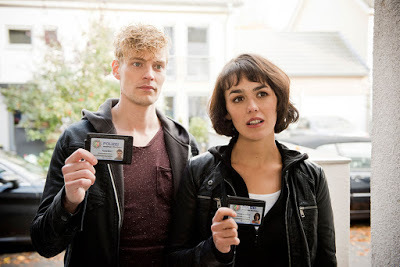 His former student Anneliese Deckert (Lucie Heinze) and her colleague Daniel Winter (Andreas Helgi Schmid) work for the criminal investigation department in Cologne. Together the trio seek to solve almost irresolvable crimes. The German version of Professor Tbegan airing in February 2017. It has currently run for three season, each consisting of four episodes, with a fourth season filmed and ready to debut.
His former student Anneliese Deckert (Lucie Heinze) and her colleague Daniel Winter (Andreas Helgi Schmid) work for the criminal investigation department in Cologne. Together the trio seek to solve almost irresolvable crimes. The German version of Professor Tbegan airing in February 2017. It has currently run for three season, each consisting of four episodes, with a fourth season filmed and ready to debut.  CZECH REPUBLIC The success of Professor T continued with a third remake set in Prague, the City of a Hundred Spires, known for its historical atmosphere and unique charm. Despite the many sights and tourist attractions, major crimes still require solving.
CZECH REPUBLIC The success of Professor T continued with a third remake set in Prague, the City of a Hundred Spires, known for its historical atmosphere and unique charm. Despite the many sights and tourist attractions, major crimes still require solving. 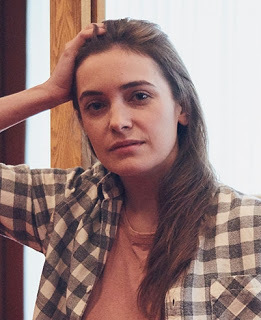 Professor T is now Jáchym Tauber (Pavel Reznícek). Inspectors Amálie Drápalová (Sarah Havácová) and Dan Winter (Aleš Petráš) dog his steps and catch his flack as they chase murderers and other assorted felons.
Professor T is now Jáchym Tauber (Pavel Reznícek). Inspectors Amálie Drápalová (Sarah Havácová) and Dan Winter (Aleš Petráš) dog his steps and catch his flack as they chase murderers and other assorted felons. 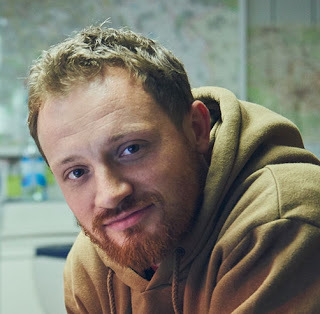 The newest version of Professor T, the Czech version has run for eight episodes over two seasons.
The newest version of Professor T, the Czech version has run for eight episodes over two seasons. With the continuing success of the franchise, there is no doubt some version of Professor T will soon be available on a streaming service near you.
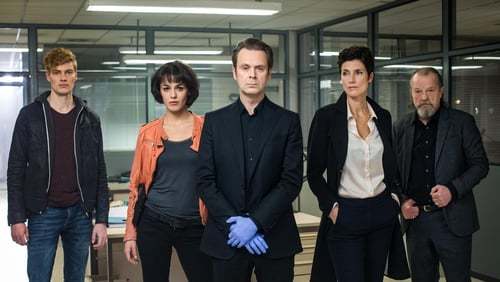

Published on September 19, 2019 16:13
September 18, 2019
WESTERN NOVELS—THE COWBOY AND THE COSSACK
 WESTERN NOVELS
WESTERN NOVELS THE COWBOY AND
THE COSSACKIf I could only choose one Western novel to recommend, it would be The Cowboy and the Cossack. The traditional cattle drive formula is given a refreshing twist when fifteen Montana cowboys sail into Vladivostok, Russia, with a herd of five hundred longhorns.
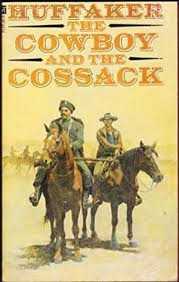 The experienced wranglers are fired up to drive their herd across a thousand miles of Siberian wilderness, but are startled to find a band of Cossacks—Russia's elite horsemen and warriors—waiting to act as an unwanted escort. Very quickly, the culture clash between American six-shooters and Russian sabers detonates the action. The sequence in which the cattle are herded off the ship to the shore is one of the greatest of all novel openings.
The experienced wranglers are fired up to drive their herd across a thousand miles of Siberian wilderness, but are startled to find a band of Cossacks—Russia's elite horsemen and warriors—waiting to act as an unwanted escort. Very quickly, the culture clash between American six-shooters and Russian sabers detonates the action. The sequence in which the cattle are herded off the ship to the shore is one of the greatest of all novel openings.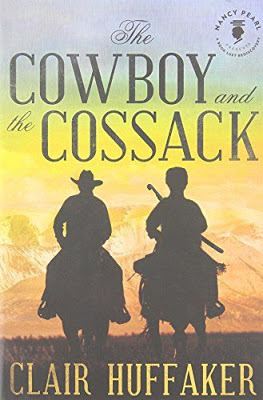 Against the sweeping majesty of a cruel winter in the Russian wilderness, two men, Shad the leader of the Montana cowboys, and Rostov the Cossack commander come into tight focus. Respect and trust are forged in the molten fire of nature fueled by a ruthless Apache-like Tartar army and powerful men whose only motive is profit. The cowboy code and the Cossack credo measure men differently, but honor and courage rises when the Wild West rides the plains of the Russian Tsars.
Against the sweeping majesty of a cruel winter in the Russian wilderness, two men, Shad the leader of the Montana cowboys, and Rostov the Cossack commander come into tight focus. Respect and trust are forged in the molten fire of nature fueled by a ruthless Apache-like Tartar army and powerful men whose only motive is profit. The cowboy code and the Cossack credo measure men differently, but honor and courage rises when the Wild West rides the plains of the Russian Tsars.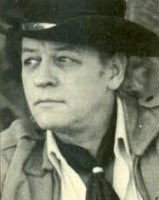 Author Clair Huffaker was a legendary Western novelist and screenwriter. His screenplays include The Comancheros, Hellfighters, and The War Wagon, which starred John Wayne. His first novel, Flaming Lance, became the basis for the Elvis Presley film Flaming Star. Huffaker also wrote for TV Westerns such as Bonanza, The Rifleman, The Virginian, Rawhide and Lawman. He served in the Navy in World War II and was an experienced cowboy, a champion boxer and a part-time smuggler. His home in Los Angeles was a gathering place for actors, stuntmen, directors and writers, all of whom could regularly be found there shooting pool, playing poker and exchanging tall tales.
Author Clair Huffaker was a legendary Western novelist and screenwriter. His screenplays include The Comancheros, Hellfighters, and The War Wagon, which starred John Wayne. His first novel, Flaming Lance, became the basis for the Elvis Presley film Flaming Star. Huffaker also wrote for TV Westerns such as Bonanza, The Rifleman, The Virginian, Rawhide and Lawman. He served in the Navy in World War II and was an experienced cowboy, a champion boxer and a part-time smuggler. His home in Los Angeles was a gathering place for actors, stuntmen, directors and writers, all of whom could regularly be found there shooting pool, playing poker and exchanging tall tales.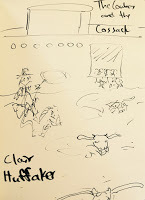 Huffaker's wife, Norma Lee Fink, was the first female prosecutor in Texas. Later, as a private practitioner, her clients included Sam Peckinpah, Franco Nero, Henry Farrell, Christopher Lee, Inger Stevens, Norman Baer, Ed Linn, Slim Pickens, and her husband, Clair Huffaker.
Huffaker's wife, Norma Lee Fink, was the first female prosecutor in Texas. Later, as a private practitioner, her clients included Sam Peckinpah, Franco Nero, Henry Farrell, Christopher Lee, Inger Stevens, Norman Baer, Ed Linn, Slim Pickens, and her husband, Clair Huffaker.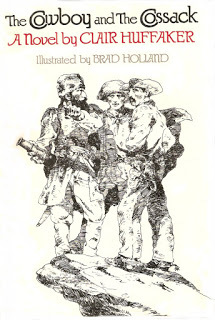 The words of Clair Huffaker's daughter, Samantha Kirkeby, perhaps explain the emotional impact of The Cowboy and the Cossack best: “As I stumbled into middle age, my fathers ability to touch people was opened up to me in a dramatic and unexpected way. I found myself reading reviews from readers all over the world. Families in Russia who considered their page worn copy of The Cowboy and the Cossack a family treasure. A wife who read the book aloud to her husband when he was ill and bedridden. An American soldier who brought me to tears when I read how The Cowboy and the Cossack was his favorite novel, and the very first thing he put into his backpack each time he left for duty. For over a decade, he carried the ragged paperback copy of The Cowboy and the Cossack he bought in a used book store to dozens of countries, reading and rereading it, passing it among his fellow soldiers to give them strength and inspiration, until the pages were frayed and worn.”
The words of Clair Huffaker's daughter, Samantha Kirkeby, perhaps explain the emotional impact of The Cowboy and the Cossack best: “As I stumbled into middle age, my fathers ability to touch people was opened up to me in a dramatic and unexpected way. I found myself reading reviews from readers all over the world. Families in Russia who considered their page worn copy of The Cowboy and the Cossack a family treasure. A wife who read the book aloud to her husband when he was ill and bedridden. An American soldier who brought me to tears when I read how The Cowboy and the Cossack was his favorite novel, and the very first thing he put into his backpack each time he left for duty. For over a decade, he carried the ragged paperback copy of The Cowboy and the Cossack he bought in a used book store to dozens of countries, reading and rereading it, passing it among his fellow soldiers to give them strength and inspiration, until the pages were frayed and worn.” 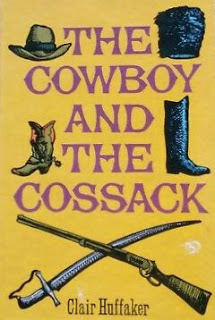 With Huffaker's ability to get his novels not only bought by Hollywood, but to also get them produced and released, it is a mystery why The Cowboy and the Cossack (arguably his best and most popular novel) has never made it to the screen. At one time producer Lance Hool held the movie rights. He famously attempted to get the film made with Clint Eastwood and Charles Bronson in the title roles, which would have been epic casting. Later, Albert R. Broccoli, the co-producer of the James Bond films, acquired the rights, but his efforts also stalled in development hell.
With Huffaker's ability to get his novels not only bought by Hollywood, but to also get them produced and released, it is a mystery why The Cowboy and the Cossack (arguably his best and most popular novel) has never made it to the screen. At one time producer Lance Hool held the movie rights. He famously attempted to get the film made with Clint Eastwood and Charles Bronson in the title roles, which would have been epic casting. Later, Albert R. Broccoli, the co-producer of the James Bond films, acquired the rights, but his efforts also stalled in development hell. 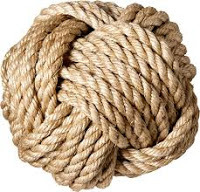 Since then, the film rights to The Cowboy and the Cossack have been twisted into a Gordian knot nobody has yet found a way to unravel. This is a travesty as The Cowboy and the Cossack, in the hands of the right director and with spot on casting, is a guaranteed summer blockbuster just waiting to happen.
Since then, the film rights to The Cowboy and the Cossack have been twisted into a Gordian knot nobody has yet found a way to unravel. This is a travesty as The Cowboy and the Cossack, in the hands of the right director and with spot on casting, is a guaranteed summer blockbuster just waiting to happen.
Published on September 18, 2019 23:51
THE COWBOY AND THE COSSACK
 THE COWBOY AND
THE COWBOY AND THE COSSACKIf I could only choose one Western novel to recommend, it would be The Cowboy and the Cossack. The traditional cattle drive formula is given a refreshing twist when fifteen Montana cowboys sail into Vladivostok, Russia, with a herd of five hundred longhorns.
 The experienced wranglers are fired up to drive their herd across a thousand miles of Siberian wilderness, but are startled to find a band of Cossacks—Russia's elite horsemen and warriors—waiting to act as an unwanted escort. Very quickly, the culture clash between American six-shooters and Russian sabers detonates the action. The sequence in which the cattle are herded off the ship to the shore is one of the greatest of all novel openings.
The experienced wranglers are fired up to drive their herd across a thousand miles of Siberian wilderness, but are startled to find a band of Cossacks—Russia's elite horsemen and warriors—waiting to act as an unwanted escort. Very quickly, the culture clash between American six-shooters and Russian sabers detonates the action. The sequence in which the cattle are herded off the ship to the shore is one of the greatest of all novel openings. Against the sweeping majesty of a cruel winter in the Russian wilderness, two men, Shad the leader of the Montana cowboys, and Rostov the Cossack commander come into tight focus. Respect and trust are forged in the molten fire of nature fueled by a ruthless Apache-like Tartar army and powerful men whose only motive is profit. The cowboy code and the Cossack credo measure men differently, but honor and courage rises when the Wild West rides the plains of the Russian Tsars.
Against the sweeping majesty of a cruel winter in the Russian wilderness, two men, Shad the leader of the Montana cowboys, and Rostov the Cossack commander come into tight focus. Respect and trust are forged in the molten fire of nature fueled by a ruthless Apache-like Tartar army and powerful men whose only motive is profit. The cowboy code and the Cossack credo measure men differently, but honor and courage rises when the Wild West rides the plains of the Russian Tsars.Author Clair Huffaker was a legendary Western novelist and screenwriter. His screenplays include The Comancheros, Hellfighters, and The War Wagon, which starred John Wayne.
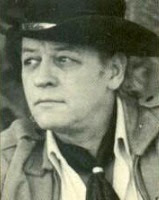 His first novel, Flaming Lance, became the basis for the Elvis Presley film Flaming Star. Huffaker also wrote for TV Westerns such as Bonanza, The Rifleman, The Virginian, Rawhide and Lawman. He served in the Navy in World War II and was an experienced cowboy, a champion boxer and a part-time smuggler. His home in Los Angeles was a gathering place for actors, stuntmen, directors and writers, all of whom could regularly be found there shooting pool, playing poker and exchanging tall tales.
His first novel, Flaming Lance, became the basis for the Elvis Presley film Flaming Star. Huffaker also wrote for TV Westerns such as Bonanza, The Rifleman, The Virginian, Rawhide and Lawman. He served in the Navy in World War II and was an experienced cowboy, a champion boxer and a part-time smuggler. His home in Los Angeles was a gathering place for actors, stuntmen, directors and writers, all of whom could regularly be found there shooting pool, playing poker and exchanging tall tales.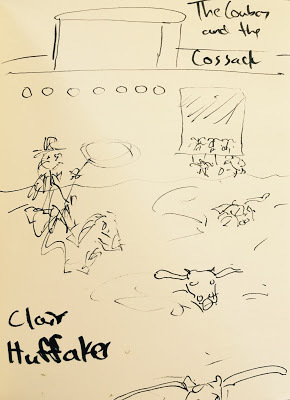 Huffaker's wife, Norma Lee Fink, was the first female prosecutor in Texas. Later, as a private practitioner, her clients included Sam Peckinpah, Franco Nero, Henry Farrell, Christopher Lee, Inger Stevens, Norman Baer, Ed Linn, Slim Pickens, and her husband, Clair Huffaker.
Huffaker's wife, Norma Lee Fink, was the first female prosecutor in Texas. Later, as a private practitioner, her clients included Sam Peckinpah, Franco Nero, Henry Farrell, Christopher Lee, Inger Stevens, Norman Baer, Ed Linn, Slim Pickens, and her husband, Clair Huffaker.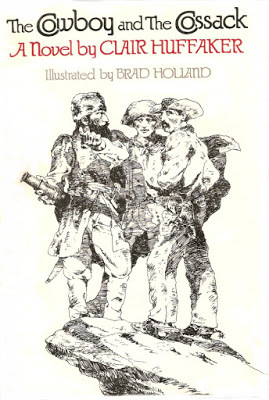 The words of Clair Huffaker's daughter, Samantha Kirkeby, perhaps explain the emotional impact of The Cowboy and the Cossack best: “As I stumbled into middle age, my fathers ability to touch people was opened up to me in a dramatic and unexpected way. I found myself reading reviews from readers all over the world. Families in Russia who considered their page worn copy of The Cowboy and the Cossack a family treasure. A wife who read the book aloud to her husband when he was ill and bedridden. An American soldier who brought me to tears when I read how The Cowboy and the Cossack was his favorite novel, and the very first thing he put into his backpack each time he left for duty. For over a decade, he carried the ragged paperback copy of The Cowboy and the Cossack he bought in a used book store to dozens of countries, reading and rereading it, passing it among his fellow soldiers to give them strength and inspiration, until the pages were frayed and worn.”
The words of Clair Huffaker's daughter, Samantha Kirkeby, perhaps explain the emotional impact of The Cowboy and the Cossack best: “As I stumbled into middle age, my fathers ability to touch people was opened up to me in a dramatic and unexpected way. I found myself reading reviews from readers all over the world. Families in Russia who considered their page worn copy of The Cowboy and the Cossack a family treasure. A wife who read the book aloud to her husband when he was ill and bedridden. An American soldier who brought me to tears when I read how The Cowboy and the Cossack was his favorite novel, and the very first thing he put into his backpack each time he left for duty. For over a decade, he carried the ragged paperback copy of The Cowboy and the Cossack he bought in a used book store to dozens of countries, reading and rereading it, passing it among his fellow soldiers to give them strength and inspiration, until the pages were frayed and worn.” With Huffaker's ability to get his novels not only bought by Hollywood, but to also get them produced and released, it is a mystery why The Cowboy and the Cossack (arguably his best and most popular novel) has never made it to the screen. At one time producer Lance Hool held the movie rights. He famously attempted to get the film made with Clint Eastwood and Charles Bronson in the title roles, which would have been epic casting. Later, Albert R. Broccoli, the co-producer of the James Bond films, acquired the rights, but his efforts also stalled in development hell.
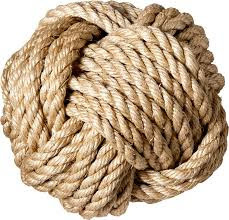 Since then, the film rights to The Cowboy and the Cossack have been twisted into a Gordian knot nobody has yet found a way to unravel. This is a travesty as The Cowboy and the Cossack, in the hands of the right director and with spot on casting, is a guaranteed summer blockbuster just waiting to happen.
Since then, the film rights to The Cowboy and the Cossack have been twisted into a Gordian knot nobody has yet found a way to unravel. This is a travesty as The Cowboy and the Cossack, in the hands of the right director and with spot on casting, is a guaranteed summer blockbuster just waiting to happen.
Published on September 18, 2019 23:51

